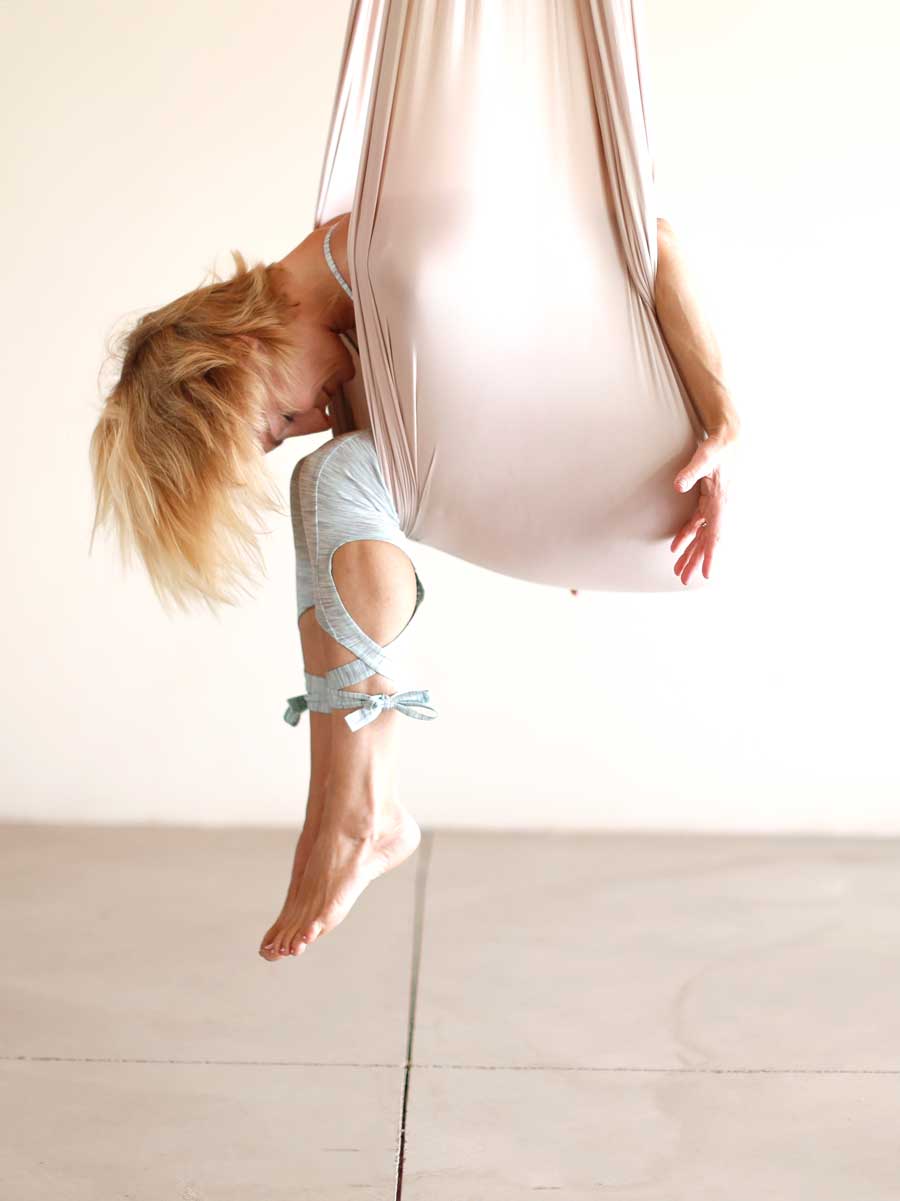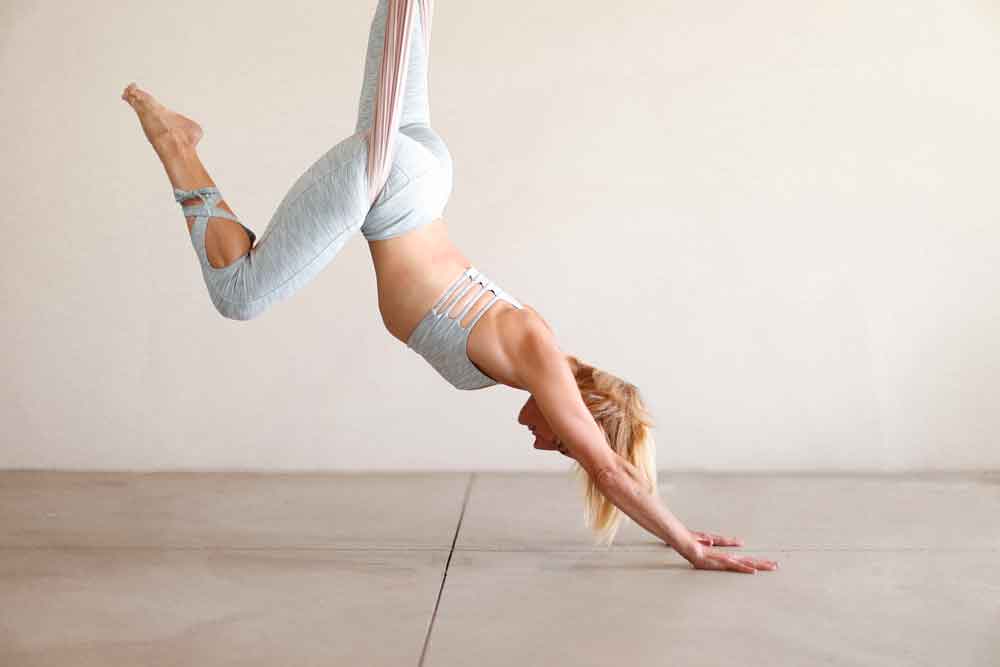Aerial Yoga: Things to Know Before You Go
By Carmen Curtis
Aerial Yoga: It’s Hang Time!
If you have not yet tried aerial yoga, there is no better time than now. When we first founded AIReal Yoga™ over 10 years ago, we were breaking ground while giving life to our dream. Our mission? To bring more yoga to everyone & anyone in the safest possible way.
Fast forward to the present. Aerial yoga and aerial fitness studios are popping up nationwide. As the demand for yoga surges the health and fitness industry continues to innovate and expand. Like traditional yoga studios, most aerial yoga studios offer a range of class styles. Perfect for any yogi or fitness fiend looking to elevate. Kids, adults, first time fliers, and daredevils alike can get their fill as they flip, fly, and flow through the air.
I am thrilled to see more and more yogis take their first flight and use the hammock to support their yoga practice! However, there are a few key things to know (and watch out for!) before you go. Firstly, it is important to know the difference between aerial yoga vs aerial fitness. There is also a huge difference between a single point rig system & a double point rig system. I will also give some tips on what to watch out for to stay safe in class. Not every aerial yoga instructor has studied yoga, and not every class is being safely led or rigged for that matter.
Aerial Yoga vs Aerial Circus and Fitness
Aerial yoga is different than aerial circus or fitness. Though they often get mixed up or misnamed.
The most important difference is that Aerial yoga is yoga, bringing union to the mind and body. In addition, aerial yoga starts with traditional yoga postures. It then links movement and breath, and integrates the use of the aerial hammock.
The hammock can be used to support the body, build strength, and create challenge. It can provide access to new postures and assist with inversions. Furthermore, it allows gravity to play a role through spinal decompression and muscle expansion. This releases connective tissue and promotes deeper openings. Similar to floor based yoga classes, aerial yoga classes differ in style, level, and focus.
Classes can include sequences that focus on flowing through yoga postures. Sequences can be about holding or repeating postures to build power and strength. There are also revolved postures and balance challenges. Often aerial yoga classes have some sort of inversions and deeply restorative postures. Aerial yoga classes can also be a combination of all of these and more. To summarize, aerial yoga is yoga using a hammock as a prop. Aerial yoga can help to make yoga accessible to all levels and styles of yoga. Most importantly, aerial yoga teachers should be certified in both traditional yoga AND aerial yoga.
What is Aerial Circus and Fitness?
Aerial circus and fitness incorporates (as you guessed) a variety of tricks and fitness movements — think floor based acrobatics, dance, bootcamp, ab labs, TRX and otherwise. In aerial fitness, being elevated provides an added layer of challenge by requiring you to fight gravity to do the series of movements. Furthermore, it adds instability that you need to overcome through activating stabilizer muscles. These classes are fun but can be very challenging as you will need to hold your own bodyweight.
Aerial circus is strength and dance based tricks on an aerial apparatus that can be linked to make dance choreographies in the air. Aerial circus uses many different types of aerial apparatus like; hammock, silks, aerial hoop, and trapeze. Most aerial fitness classes concentrate on strength building through repetition and aerial circus classes focus on learning skills and tricks that are fun and look cool, but are not always good for your body long term.
Aerial Circus is a performance art and a fun form of fitness, but not for all levels, aerial circus is much more challenging than aerial yoga. With aerial yoga you can modify and make it a form of self healing, aerial circus will be more demanding to the body. It is important to make sure the teachers have had years of practice and have gone through an aerial teacher certification.
Do Your Research!
Do your research first, determine which studio and class is best for your body. Then try as many as possible that are appropriate for you! The more you try, the more information you will gather. The more informed you will be, and the better equipped you will be to make the appropriate decision for you.
Aerial Rigging: Single vs. Double Points

Do your research first, determine which studio and class is best for your body. Then try as many as possible that are appropriate for you.
The way the hammock is connected to the ceiling structure makes a major difference in the style of class that can be offered. Our company, AIReal Yoga™, uses a Single Point (see the benefits of a single point below). Whereas other Aerial brands and studios use a Double Point. The point is a general term for the place the hammock connects to the ceiling structure (or rig system).
A Single Point system connects each end of the hammock to a single swivel with connective gear, such as a slings, daisy chains, or a carabiner. This creates a loop, or a long teardrop shape, with the fabric of the hammock. The swivel is then attached to a single connective point in the ceiling structure (or rig system) with additional connective gear.

A Double Point system connects each end of the hammock to a separate stationary piece of hardware. Such as an eye-bolt, with connective gear. This creates a long U-shape with the fabric of the hammack. It also creates two separate connection points in the ceiling structure (or rig system). Hence, there is no swivel in this system.
Certainly the Single and Double Point systems both allow for a variety of classes. Futhermore, if rigged and installed correctly, both are safe . Single Point Systems are the most versatile and are best for yoga and can also offer fitness and circus classes. Double Point systems are best for fitness classes. Similarly, in both systems, the practitioner can change the height of the hammock in relation to themselves and the floor.
Benefits of the Single Point System
At AIReal Yoga™, we developed our entire program on the Single Point swivel system. I have been doing aerial hammock for over 20 years. We have found that for a yoga practice it is best on a single point. Which helps to make yoga accessible and safe for all.
Here are some of the benefits of single point aerial yoga you can expect to enjoy:
1. FLOW: THE FULL SPECTRUM OF YOGA POSTURES.
The Single Point allows you to flow through postures without interference. It allows you to perform revolved postures without the tug of the other side of the hammock. The swivel allows for smooth transitions. It allows for the ability to turn and move freely yet supported at the same time. A double point does not allow for this full spectrum. The two connective points will interfere with flow. It will pull you out of revolved postures. A double point will also fight against you when trying to do yoga twists.
2. SAFETY: ADDED SUPPORT & STABILITY.
The hammock on a Single Point can be used as a prop to support. A single point allows the practitioner to move in a way that is appropriate for them. For beginners, the hammock can be used as a spotting device. Hammocks allows the practitioner to safely enter into and experiences new yoga postures. It does all this in a safe and stable way. The Single Point wraps you for added safety and stability while in inversions. A single point also offers a snug floating savasana, indulging the senses as you feel hugged, safe and supported. The double point is more open so it can be easier to fall out of.
3. A HEALTHY CHALLENGE.
The hammock on a Single Point and swivel adds a level of instability. It challenges the practitioner to activate their stabilizer muscles throughout the entire practice. Offering support but at the same time forcing them to be internally aware and awake. Adding enough support for the beginner and the advanced yogi alike. But not too much support that would inhibit them from progressing. Ultimately, aerial yoga can make yoga easier or more challenging. It is simply in the way you use it for each posture. Imagine performing balancing postures, such as Warrior 3. Now incorporate the movable component of your hands wrapped in the hammock. The stabilizer muscles of your outer hips, glutes, and core are active the entire time. You are constantly adjusting, trying to find your center to maintain balance. This healthy challenge helps build major and minor muscle groups throughout the entire practice. On the other hand, while the double point does offer stability and support. At same time it becomes too stable and inhibits progression. Thus the advanced practitioner would be limited from progressing.
4. CONTINUOUS PROGRESSION.
Many practitioners hit a wall in their practice with challenging poses. For example, balance poses and inversions such as, Forearm Stand and Handstand. The hammock on a Single Point supports a portion of your body weight and acts like a guardrail. With the body supported by the hammock, you can build the necessary upper body strength. It will also allow you to establish a strong foundation. Ultimately this will allow you to perform the full expression of the posture. First with the hammock. And eventually without the assistance of the hammock.
5. THE SWEETEST SAVASANA.
The hammock fabric, when connected to a single point, can be spread long. This allows it to extend from below the toes to above the head as you lay in it. It then encloses above the practitioner as it extends upward to the single point to create a cocoon. During restorative postures the support of the cradle promotes feelings of stability and security. This variation of Floating Savasana is one of those postures people never want to get out of. We love to offer it for 15-20 minutes in a class known as Heavily Levitated. It is one of the most popular studio and festival classes we offer!
6. A TEACHER’S TOOL.
As a teacher, the swivel allows teachers to access to view the full landscape of the room. We can keep a continuous eye on the entire class, turning and moving. Plus, while providing adjustments to students, the swivel allows us to turn a student. This enables us to provide more impactful adjustments from various angles.

When I developed AIReal Yoga, I was intent on two things. One being sharing the benefits of yoga with as many people as possible. And two doing so in the safest possible way. After years of competitive gymnastics. Practicing and educating myself in several styles of yoga. Two pregnancies, and an ever-changing maturing body. The Single Point system we developed with AIReal Yoga has consistently provided me with benefits. The yoga experience and physiological benefits my body yearns for. From rebuilding strength to challenging my balance. To inversions to decompression and relaxation. It is all there in the hammock.
“What if I Fall? Oh, but my darling what if you fly?” – e.h

Sign up for our online aerial yoga classes and check out our AIReal Yoga Assist Training Workshop that talks more deeply about how to use the single point to assist and guide your students safely.
